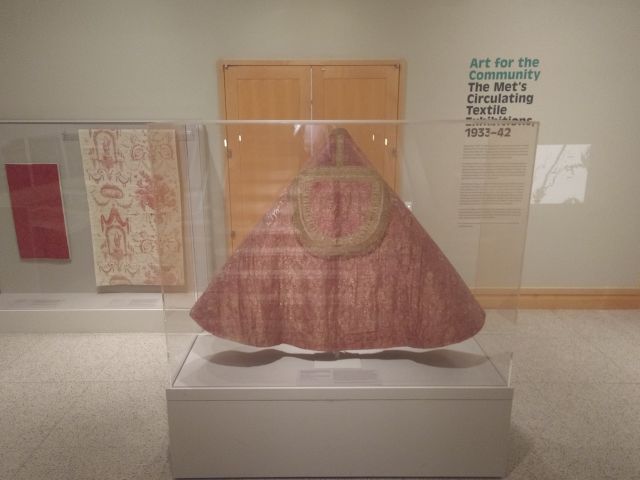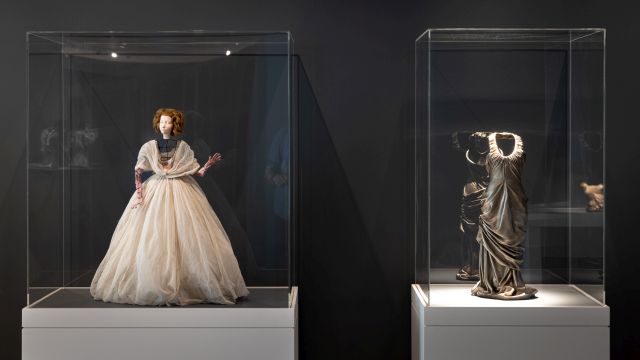We’ve arrived at a new year, and with that comes a new cycle of monthly exhibition posts. Today, let’s circle back to the Neighborhood Circulating Exhibitions by taking a look at European Textiles and Costume Figures.

Historical Background
European Textiles started out as half of the exhibition Arms and Armor, Textiles, and Costume Dolls: An Exhibition of European Art, 1492-1776. By 1935, that exhibition had become two different shows, one focusing on armor, the other on, well, textiles.
As far I can tell, European Textiles and Costume Figures was one of the Neighborhood Circulating Exhibitions’ most frequently-exhibited shows. Whereas Arms and Armor only appeared in the schedule about six or seven times between 1935 and 1939, the Met showed European Textiles at least sixteen times between 1935 and 1942. Practically speaking, this makes sense since textile samples and dolls are a lot easier to transport than fully-armored horse mannequins. But it’s still worth pointing out because it suggests the kind of work that viewers of the Neighborhood Circulating Exhibitions were most likely to see.
What’s in the European Textiles and Costume Figures?
European Textiles and Costume Figures consisted of historical fabric samples and fragments from the collection, as well as the occasional full-size garment. Modern, miniature mannequins dressed in replicas of period attire supplemented the historical objects. Requiring less fabric and easier to transport than life-sized mannequins, these miniatures provided a practical, economical way to show viewers how the historical samples might have appeared as clothing. Eventually, after the Neighborhood Circulating Exhibitions ended, the museum deaccessioned the mannequins and their costumes. After all, the Met staff regarded them as educational tools rather than collections objects. I still would have loved to have seen them in person, though.
Like the other Neighborhood Circulating exhibitions, the pieces on view in European Textiles and Costume Figures periodically changed or rotated. Extant checklists show objects being removed, added, or substituted as they made their way to different venues. As a result, viewers could potentially see a different show depending on which site they visited.
My Thoughts on European Textiles
Of all the Neighborhood Circulating Exhibitions, I probably feel closest to this one. A lot of that has to do with Art for the Community, an exhibit I attended in 2021. Since this show appeared in the foyer of the Antonio Ratti Textile Center, it focused on the exhibitions’ textiles. At the exhibition, I got to see some of the works that appeared in the shows, including an ostentatious cope designed for Antonio Barberini, nephew of Pope Urban VIII.
Grant it, I’m sure I’ve seen other objects from the Neighborhood Circulating Exhibitions, from armor to scarabs. But in the case of the textiles, particularly the Barberini cope, I definitely know some of the pieces that the museum staff included. Being able to positively identify the objects and see them in person gave me a tactile connection to the shows. Important as the historical photographs are, I don’t get that same immediacy from them. Seeing the objects in person helps me better imagine their travels around the city eighty years ago.
Barry Art Museum Connections
I also feel a personal connection to this show because the costume figures remind me of the Barry Art Museum. While the mannequins’ miniature scale is certainly similar to the dolls I’ve been working with, the show most immediately reminds me of another exhibition, Karen LaMonte: Théâtre de la Mode. This was the show that occupied the main rotating gallery before Motion/Emotion. It showcased works from LaMonte’s Nocturnes as well as some of her Études, works produced at 1/3 scale. LaMonte took inspiration from the Théâtre de la Mode, a postwar traveling exhibition comprised of fashion dolls dressed in French couture. That postwar project, in turn, referenced the tradition of Pandora dolls circulating fashions around Europe in the centuries before the popularization of prints and magazines (as did European Textiles and Costume Figures) The Barry exhibit even included a few replicas of these mannequins to give context to LaMonte’s work.

To be fair, the two exhibitions had different functions. Yet with their mutual emphasis on scale, economy, and mobility, I can’t help but see connections between the two shows.
Next Month’s Exhibition
So there you have it for this month’s exhibition. In February, we’ll return to the CACP and check out some more textiles. This time though, we’ll check out some modernist designs from artist and Index of American Design co-founder Ruth Reeves. See you then!